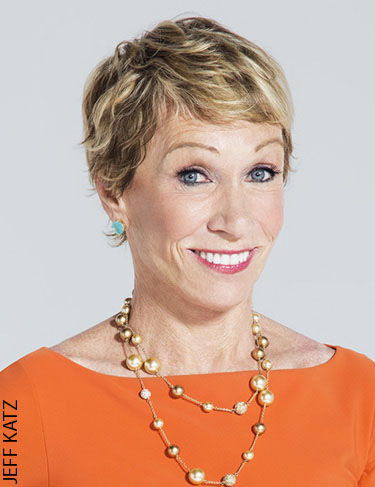 Investor: Barbara Corcoran
Investor: Barbara Corcoran
Shark Tank Appearance: April 22, 2011
Deal: $50,000 for a 25 percent stake
Results: Sales increased from $27,000 to $5 million
On a Saturday afternoon, some five years after Kim Nelson appeared on Shark Tank, she’s standing in the Pauline, South Carolina, commercial kitchen of her company, Daisy Cakes, sifting powdered sugar “so it’s perfectly smooth and there won’t be a single bump or bubble in the icing.” As she sifts, Nelson reflects on the time since she handed slices of her carrot, red velvet and lemon cakes to the Sharks and landed Barbara Corcoran as her investor and mentor.
Just because Nelson has turned into what Corcoran has called one of the best deals she’s made in the eight seasons of ABC’s business-reality show doesn’t mean you can stop sifting sugar, even on weekends. “The lengths we go to are ridiculous,” Nelson says, “but we want our customers to love every single thing about our cakes—from taste to packaging—and have an eyes-rolling-back-in-their-heads experience when they take that first bite.”
Still, Nelson has discovered that although you can smooth every ripple out of cake batter and icing, you can’t avoid some bumps on the road to success.
Related: 9 Entrepreneurial Lessons You Never Learned in School
Nelson went from selling 2,000 cakes in two years pre-Shark Tank to the same amount of orders in the first 48 hours after the episode aired. Corcoran found a large-production bakery in Savannah, Georgia, to handle the increased demand. “I loved our new baker,” Nelson says, “and they loved us. All seemed wonderful.”
Until Daisy Cakes landed a spot on QVC. That’s when the production bakery Nelson was using to create her goods fired them as a customer because the bakery was selling its own cakes on QVC. “Now we were competition,” Nelson says. With Corcoran’s help, Nelson located another production bakery, this one in the Bronx, New York. They worked with a nearby QVC-approved fulfillment house in Long Island. “It seemed like the ideal setup,” Nelson says. “I was certain this time everything would work out beautifully.”
When Nelson appeared on QVC on Nov. 30, 2011, the Daisy Cakes inventory of 5,000 cakes sold out in eight minutes, and the home-shopping network asked Nelson to make a return appearance in a couple of weeks. Bingo, right?
Not so fast. “We ran out of money,” Nelson says. “We were flat broke.” That’s because while Nelson had sunk cash into baking supplies to create that inventory for QVC, it would be 60 days before the network paid them. Making matters worse, the busy holiday season was falling right in the middle of that cash flow gap. “We’d gotten too big too fast,” Nelson says, a trap many young companies fall into.
A cash-strapped Nelson had to borrow $50,000 from a friend and a family member just to buy ingredients to fulfill Christmas orders. “In all of my life, that is the most desperate I’ve ever been and all I could think about was doing anything to keep the business going for at least a few months until I could figure something else out,” Nelson says. “And it was one of the absolute worst decisions I’ve ever made in my entire life.”
Nelson managed to ride that crisis out only to be hit with another one. The quality of the cakes the Bronx bakery was producing was dismal, both in appearance and flavor. When customers complained, Nelson would send them a replacement cake and, as an apology, a second free cake, but sales fell by 50 percent.
Related: 11 Ways Master Entrepreneurs Make Unhappy Customers Happy
By summer 2012, Nelson turned to yet another large baker, this one in Nashville, Tennessee, and to two fulfillment centers, one in Maryland for cakes being shipped east of the Mississippi and one in Kansas City, Missouri for cakes going to the Midwest and West. Then, in the beginning of 2013, a huge order for 6,500 cakes was spoiled by sugar bloom—unsightly crystallized spots. Nelson says the blow was catastrophic, causing a loss of $150,000 in inventory and $310,000 in sales.
Corcoran was clear on what had to happen next: Move production back to Pauline and to the bakery that Nelson’s dad had built for her years before. “Bigger is not always better,” Nelson says. “We’re a small business, and every cake is handmade and wrapped by hand. It’s a labor of love, and volume doesn’t decrease the cost of making each cake.”
“We want our customers to love every single thing about our cakes—from taste to packaging—and have an eyes-rolling-back-in-their-heads experience when they take that first bite.”
Today Daisy Cakes is turning out about 20,000 cakes a year, which hits the sweet spot for their seven ovens and six full-time employees, besides Nelson and her 83-year-old mom, who’s been a part of the business from the beginning. They’ve recently introduced minikins, 8-ounce cakes sold in jars, which have been well-received. Nelson has a new cookbook coming out in early 2018, and she’s beginning to think that franchising Daisy Cake bake shops might be a solid avenue to growth. “The cakes would have to be baked exactly the way we bake them here in Pauline,” she says, “and that takes love, passion and following a very, very strict set of rules.”
Related: 6 Things You Want Your Customers Saying About Your Business
This article originally appeared in the August 2017 issue of SUCCESS magazine.




